

The Three-phase railcar (Ger: Drehstrom-Triebwagen) was an experimental railcar built in Germany at the beginning of the 20th century to assess the possibilities in using electric motive power for rail transport.


The Three-phase railcar (Ger: Drehstrom-Triebwagen) was an experimental railcar built in Germany at the beginning of the 20th century to assess the possibilities in using electric motive power for rail transport.
The 19th century saw the invention of the modern railway and their rapid expansion into national networks in Europe and worldwide. During this period motive power was confined to steam locomotives, some of which by mid-century were capable of top speeds of 80 miles per hour (130 km/h), with average express journey speeds of 50–60 mph (80–97 km/h).
The 1880s saw the development of electric power and its application to rail transport. Electric power offered several advantages over steam; it is more efficient, allowing more rapid acceleration, and a higher power output when necessary. Its disadvantage is the high initial cost of the infrastructure involved, such as the power production and distribution system needed. 1879 saw the demonstration of an experimental system by Werner von Siemens in Berlin, which was followed by an electric tramway at Lichterfelde, in 1881, and heavy rail applications in 1890 (the City and South London Railway) and 1895 (the Baltimore Belt Line).
In 1899 a consortium of ten of the largest and wealthiest companies in Germany joined to form the "Research Association for High-speed Electric Railways"(de) (Studiengesellschaft für elektrische Schnellbahnen, or St.E.S.) to examine the possibilities of high-speed electric rail travel.
The St.E.S consortium, which included Siemens & Halske, the engineering company AEG, and the Deutsche Bank, was founded on 10 October 1899 and given leave to electrify a length of the Royal Prussian Military Railway between Marienfelde, near Berlin, and Zossen, a distance of 23 kilometres (14 mi). The line was electrified with three-phase power at 10 kV/50 Hz, using three overhead lines on poles that were about 5 to 7 metres (16 to 23 ft) high located at the side of the track. This work was completed by the spring of 1901.
The society commissioned two railcars for testing. These were built by Van der Zypen & Charlier , a Cologne rolling-stock manufacturer and consortium member, with Siemens and AEG supplying the electrical equipment. The cars were of standard size, with a capacity for 50 passengers, mounted on two six-wheel bogies, the outer axle being motorized. The power was drawn down from the three power cables running along the side of the track by three vertical catenaries, mounted on two towers fore and aft on the roof of the carriage. The electrical system was rated at 6–14 kV, operating at 25–50 Hz, giving a power equivalent of 1,475 hp (1,100 kW). [1]
The summer of 1901 saw a series of test runs, culminating in record-breaking speeds of 160 kilometres per hour (99 mph). These tests revealed weaknesses in the trackbed, which had to be re-laid. Following this, in the autumn of 1903, a series of high-speed runs were achieved; of 206 kilometres per hour (128 mph), by the Siemens railcar, on 6 October, and 210 kilometres per hour (130 mph), by the AEG railcar, three weeks later, on 28 October 1903. This set a railway speed record for electric locomotives which stood for the next 51 years. [2]
The tests had shown what was possible with electric motive power, but the three-phase system was too complex, and the cost of installation too prohibitive, for general use across the rail network. With this the St.E.S was wound up and the infrastructure dismantled.
Advances in technology, particularly in semiconductors, are believed to offer new possibilities with the three-phase system in the 21st century. [3]

A diesel multiple unit or DMU is a multiple-unit train powered by on-board diesel engines. A DMU requires no separate locomotive, as the engines are incorporated into one or more of the carriages. Diesel-powered single-unit railcars are also generally classed as DMUs. Diesel-powered units may be further classified by their transmission type: diesel–mechanical DMMU, diesel–hydraulic DHMU, or diesel–electric DEMU.

A locomotive or engine is a rail transport vehicle that provides the motive power for a train. If a locomotive is capable of carrying a payload, it is usually rather referred to as a multiple unit, motor coach, railcar or power car;
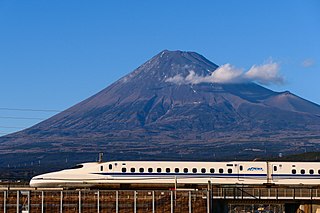
High-speed rail (HSR) is a type of rail transport network utilizing trains that run significantly faster than those of traditional rail, using an integrated system of specialized rolling stock and dedicated tracks. While there is no single standard that applies worldwide, lines built to handle speeds above 250 km/h (155 mph) or upgraded lines in excess of 200 km/h (124 mph) are widely considered to be high-speed.

A diesel locomotive is a type of railway locomotive in which the power source is a diesel engine. Several types of diesel locomotives have been developed, differing mainly in the means by which mechanical power is conveyed to the driving wheels. The most common are diesel-electric locomotives and diesel-hydraulic.

An electric locomotive is a locomotive powered by electricity from overhead lines, a third rail or on-board energy storage such as a battery or a supercapacitor. Locomotives with on-board fuelled prime movers, such as diesel engines or gas turbines, are classed as diesel-electric or gas turbine-electric and not as electric locomotives, because the electric generator/motor combination serves only as a power transmission system.

The Bombardier–Alstom HHP-8 is a type of twin-cab electric locomotive manufactured by a consortium of Bombardier Transportation and Alstom for Amtrak and MARC. The locomotive's electrical drive technology is directly derived from the SNCF BB 36000 manufactured by Alstom.

The New Zealand EF class locomotive is a class of 25 kV 50 Hz AC electric locomotives that operate on the North Island Main Trunk (NIMT) between Palmerston North and Te Rapa in New Zealand. Built by Brush Traction in Loughborough, England between 1986 and 1988 to run on the new electrified central section of the NIMT, at 3,000 kilowatts (4,000 hp), they are the most powerful locomotives to operate in New Zealand.

TGV 001 was a high-speed railway train built in France. It was the first TGV prototype and was commissioned in 1969, to begin testing in 1972. The TGV 001 was an experimental gas turbine-electric locomotive-powered trainset built by Alstom to break speed records between 250–300 kilometres per hour (160–190 mph). The experimental train was part of a vast research program on high rail speeds. This program covered all technical aspects, principally traction, the behaviour of the vehicles, braking, aerodynamics and signalling. Originally, two trains were to be built, but only one was produced. The second was to be a tilting train equipped with an active tilting system, but was abandoned owing to technical difficulties.
The TGV is France's high-speed rail service. The idea of a high-speed train in France was born about twenty years before the first TGVs entered service. At that time, about 1960, a radical new concept was thought up; combining very high speeds and steep grades would allow a railway to follow the contours of existing terrain, like a gentle roller coaster. Instead of one or two percent grades which would be considered steep in normal applications, grades up to four percent would be feasible, thus allowing more flexible routing of new lines. Over the next several years, this very general idea gave rise to a variety of high speed transportation concepts, which tended to move away from conventional "wheel on rail" vehicles. Indeed, the French government at the time favoured more "modern" air-cushioned or maglev trains, such as Bertin's Aérotrain; Steel wheel on rail was considered a dead-end technology. Simultaneously, SNCF was trying to raise the speeds of conventional trains into the range 180 to 200 km/h for non-electrified sections, by using gas turbines for propulsion. Energy was reasonably cheap in those years, and gas turbines were a compact and efficient way to fulfil requirements for more power. Following on the TGS prototype in 1967, SNCF introduced gas turbine propulsion with the ETG turbotrains in Paris - Cherbourg service, in March 1970.

The InterCity 250 was an electric railway project undertaken by British Rail in the late 1980s. The InterCity 250 train would have consisted of a Class 93 electric locomotive, nine Mark 5 coaches and a Mark 5 Driving Van Trailer operating in a push-pull formation. The British Rail project was cancelled in July 1992.

The EuroSprinter family of electric locomotives is a modular concept of locomotives for the European market built by Siemens Mobility. The internal Siemens product name is ES 64, with ES for EuroSprinter and the number 64 indicating the 6,400 kW power at rail.
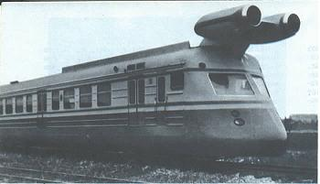
A turbojet train is a train powered by turbojet engines. Like a jet aircraft, but unlike a gas turbine locomotive, the train is propelled by the jet thrust of the engines, rather than by its wheels. Only a handful of jet-powered trains have been built, for experimental research in high-speed rail.

SNCF's CC 7100 class are part of a series of electric locomotives built by Alstom. The prototype 'CC 7000' were built in 1949 and the production series locomotives CC 7101-CC 7158 followed during 1952–1955. Two of the class are notable for setting world rail speed records: CC 7121 reaching 243 kilometres per hour (151 mph) on 21 February 1954, and CC 7107 reaching 331 kilometres per hour (206 mph) on 28/29 March 1955.
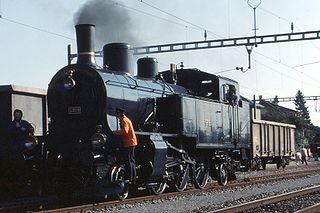
For more than a century, the Swiss locomotive, multiple unit, motor coach and railcar classification system, in either its original or updated forms, has been used to name and classify the rolling stock operated on the railways of Switzerland. It started out as a uniform system for the classification and naming of all rolling stock, powered and unpowered, but had been replaced and amended by the UIC classification of goods wagons.

The Rhaetian Railway Ge 2/4 was a class of metre gauge 1′B1′ electric locomotives formerly operated by the Rhaetian Railway (RhB), which is the main railway network in the Canton of Graubünden, Switzerland. Four members of the class are now preserved, with one of them in operational condition.

Three-phase AC railway electrification was used in Italy, Switzerland and the United States in the early twentieth century. Italy was the major user, from 1901 until 1976, although lines through two tunnels also used the system; the Simplon Tunnel between Switzerland and Italy from 1906 to 1930, and the Cascade Tunnel of the Great Northern Railway in the United States from 1909 to 1939. The first standard gauge line was in Switzerland, from Burgdorf to Thun, from 1899 to 1933.
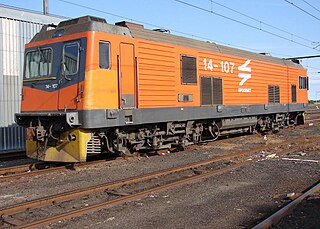
The Spoornet Class 14E1 of 1994 was a South African electric locomotive.
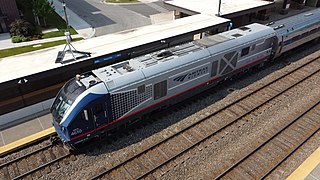
The Siemens Charger is a family of diesel-electric/dual-mode passenger locomotives designed and manufactured by Siemens Mobility for the North American market.
The Royal Prussian Military Railway, also called the Königliche Militär-Eisenbahn, was a Prussian state railway, operated by the army, between Schöneberg and Kummersdorf, later extended to Jüterbog.
Electric Multiple Units (EMU) are powered on the metro network of Athens, with five or six coaches. EMU-5s are of a former type and are limited to Line 1. On Lines 2 and 3, routes are only operated with EMU-6s. The trainsets were put into operation by STASY in 2011, with its establishment.